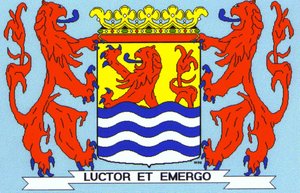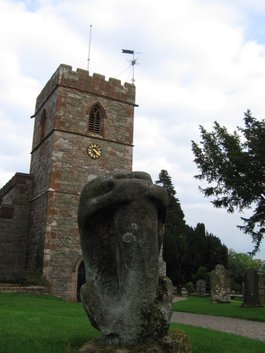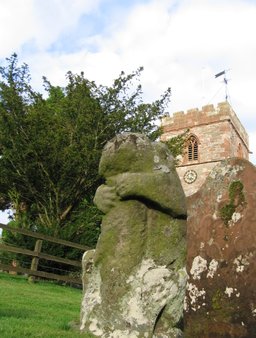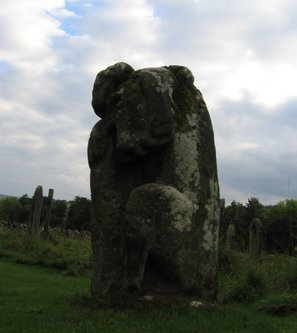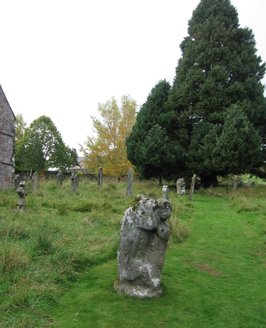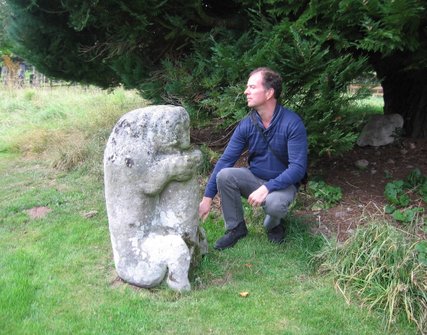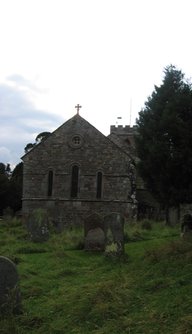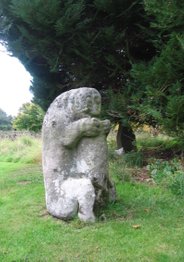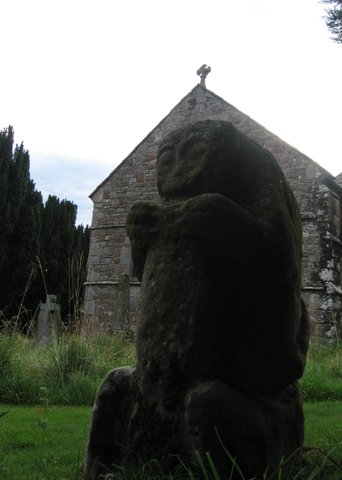The Dacre 'bear' statues of St. Andrew's Church, Cumbria - a case of 'luctor et emergo' in retrospective ?
In this blog we move on to another type of mysterious stone sculptures, where is much debate about from wich period of time they are dating. Their symbolism is even more mysterious - but I have a daring theory about them, inspired on the weapon (flag) of the Dutch provence of Zeeland.
The weapon depict a struggling lion who overcomes the water, as a symbolism of Holland's ever struggling against the water. 'I struggle and I will rise above the water' is my somewhat 'stonecoalish' translation of the line 'luctor et emergo'. But what on earth would I relate this to the four mysterious stone figurines on a graveyard in Dacre, Cumbria, England ?
I address that a bit later on..
Of unknown origin the so called 'Dacre Bears' have been puzzling for centuries. There is speculation that the bears are in fact lions, dating possibly from Roman times. Other theories have suggested they date from the mediaeval era. In my opnion the discussion if it are bears or not I will engage, but lions.. ?
In 1890 Chancellor Ferguson thought that he had an answer and said - or better: had a theory - that the bears told a humorous story in four stages.
The first, the bear (now sadly missing its head) is seen holding a post with its front and rear paws. We see the bear missing its head, or was it deliberately casted without head ? Why I am suggesting that, I will address later on.
In the second, the bear has a small animal on its back - not very clear on the photo though, perhaps a cat or a lynx, and is turning its head to see what is there.
Ok. A.D. 2015, would we still consider it to be a cat or lynx attacking the lion, it would have been a courageous one, as they are considered by some to be lions. I leave that thoughts upon you..
In the third, (left photo beneath) the bear has flexed its shoulder and is anxious to remove the animal. This is the most crudely worked of the pieces, perhaps because of its complexity.
Finally, the bear has a smug, satisfied look on the face, as if he has eaten the creature. (photo's on the right beneath and thereunder).
This carving is the best preserved and with a clear mane and tail, suggesting the bear is indeed a lion. (as stated in the folder, available in St. Andrews's church itself). Again.. if it is a lion, wich animal would have the nerve to crawl upon its back ?...
When I was examing the 'last' statue, I was mentioning a half holemark on the head. Also I had the strange feeling that what I was watching as well could be very old, or almost could be extraterristial, as strange as it may sound..
The bears were first recoreded in 1704, but are clearly much older. No one knows their original locations - suggestions include on the church tower, or on the battlements or a gateway of Dacre Castle. Each of the four creatures has a depression on top - too swallow for a flaghole, but just the right size for a candle or a wick floating in oil.
My theory then, - at last for the symbolism - is Good overcoming the force of Evil. If Good is starting losing its head, it is getting unaware of the Evil and is attacked by it. Waking up just in time, one refinds his head (sense) and fights its way back.. luctor et emergo.
Any suggestions can be mailed to me, vikingsandartefacts@yahoo.com or can be addressed to the church itself at: admin@dacrechurch.com
In the forthcoming blog I take you to two another interesting stone sculptures, inside the church of Dacre..
Link to prior blog of October 26th 2015
See for reference:
Holder, G. The guide to the mysterious Lake District, The History Press, 2009
Folder available at St. Andrew's church in Dacre.
Well. I could have been with these stones until after dark, but as my wife wanted to travel on.. well.. I see you again, some day, hogback stones from Gosforth. And if you happen to be there one day, do not forget that monument on the outside...
Further on with the Cumbrian hogbacktour !
In - yes, luckily again in - St. Peter's church in Heysham, there is a truly beautiful hogback stone. The guide told us, it had been studyied by Thor Ewing, a writer, in 2000. in 'Understanding the Heysham hogback' A tenth century sculpted stone monument and its context (link), Thor Ewing tells in detail what he dicovered on the both sides of this hogback stone.
Just being brought in the church as late as the 1970's accompanied with some protest here and there among the church visitors, considered as being a token of old paganism, it had been remarkably nice preserved, and a lot of detail can be seen, still. Truly worthwile a visit.
I had a small debate with the guide in the church if the - zoomorphic, in my opinion - faces on the sides were lions (or hippo's). The guide doubted if the vikings could have known about lions. Well I guess so, concerning the runes on the Ancient Greek lion statue at the Arsenal, Venice. For example. Vikings did travel south..
But when he told me he was doubting the vikings 'discovered' (as the native inhabitants were of course, in the first place) America before Columbus, I decided to rest my case..
One has to know when to start and to end a conversation ..
Just discovered the book in a bookstore written by Geoff Holder - The guide to the mysterious Lake District, I knew there had to be another hogback stone in Lowther, St. Micheal's Church. With a promising image described in the text of 'a naval and a land-based force of shield-bearing vikings above a fish and what might be a coiled sea serpent. On the reverse is a row of female figures with snakes, possibly a representation of the hideous hag Hel'. Wow. If that did not sound as a true pagan promised land ..
Not complaing too much after all we have seen, this visit was the dissapointing one of them all. But if you wife states 'I am happy to have seen them' and I am answering 'Measuring is knowing' and the even more obligate verb 'handling 'if we did not see it at all, we wouldn't have known anything at all of how they were looking' the glass was again half full, at the last day of our journey..
The hogback stone appeared to be just being tolerated within the entrance segment part of the church. As something you never use anymore but you do not throw away - entirely. That sort of feeling emerged when seeing this hogback asylum seekers.. Bed, bath and bread, ás we say in Dutch, but no luxury at all and standing on some outcuts of wood, you would balance the table with at home..
Come on, St. Micheal's Church.. care a bit more of your 'children' !
This hogback stone was moved in the church in 1907. Hogback stones layed partially buried in the churchyard before it was dug up and moved into the church.
The promising depiction of a longship - as certainly can be seen after some studying - see http://vikingminds.co.uk/pages/longship
we have missed !
The stone itself is (157 x 50 x 30 cm) and very worn.
The hogback stones in Cumbria - very diverse in quality, but everyone worth a visit ! Especially on a gloomy day in late October ...
The churches to visit - see photos of resp. St. Andrew's church in Penrith, St. Mary's church in Gosforth, St. Peter's church in Heysham and St. Micheal's church in Lowther.
Did I miss out on another one in Cumbria ? Let me know !
In a next blog I will take you to four - still remaining utterly mysterious- statues 'guarding' the graveyard of St. Andrew's church in Dacre..
For the last blog of October 9th see this link.
References: (as always, links to where the books can be ordered are attached).
Edwards, B.J.N. Vikings in North West England - The artifacts (1998);
Emery, Gordon, CURIOUS CUMBRIA, The Lake District & Beyond: A celebration of Cumbria (2023)
Ewing, T. 'Understanding the Heysham hogback' A tenth century sculpted stone monument and its context ;
Hall, R. Viking Age archaeology in Britain and Ireland (first printed 1990, reprinted with amendments in 1995);
Holder, G. The guide to the mysterious Lake District (2009)
possibly also (as there within the part of Cumbria dealing with Carlisle, the Eden Valley, Barrow-in-Furness, Whitehaven and the west coast is being dealed with)
Holder, G. Paranormal Cumbria (2010)
http://vikingminds.co.uk/pages/longship
